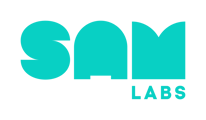How was the SAM Labs curriculum created?
Two research-based strategies were used in the creation of the SAM Labs' curriculum.
Principle 1 - Technology, when supplementary to teacher-led instruction, supports learning attainment. The inclusion of technology supports the curricular objectives but is not the focus of the curriculum. In the STEAM course, the focus of the lesson is on the NGSS standard. Students then bring the science standard to life through coding and prototyping with the technology. The SAM Blocks and SAM Space coding platform are utilized as a tool to facilitate abstract learning about the science concept and make the learning tangible.
Principle 2 - Teachers are the greatest known mediator of students’ learning attainment. The following are included in every lesson plan for the teacher to adapt and tweak for their instruction and student needs:
1. Make the abstract concrete - In the modular lesson structure, the Warm-Up uses a real-world example and unplugged activity to introduce the content
2. A worked example - Every lesson has a “Let’s Build” segment which is a teacher-led step-by-step demonstration of how to perform a task or solve a problem. This scaffolds the learning for the students before they try to build a program in their small groups.
3. Multiple, complementary modalities - Every lesson comes with a slide deck for teachers to use during instruction. The slide deck includes many visuals so the teacher can explain what’s happening (visual and auditory). The unplugged activities in the Warm-Up and Mini-Lesson get students out of their seats and activating their prior knowledge on the content (kinesthetic). Lastly, the prototyping and use of SAM Blocks in every lesson allow hands-on learning (tactile).
4. Use a story, real-world application or mnemonic - This can help students learn to impose meaning on hard-to-remember content
5. Provide formative assessment opportunities - Every lesson has a standards-aligned formative assessment to track student attainment and provide progress data.
